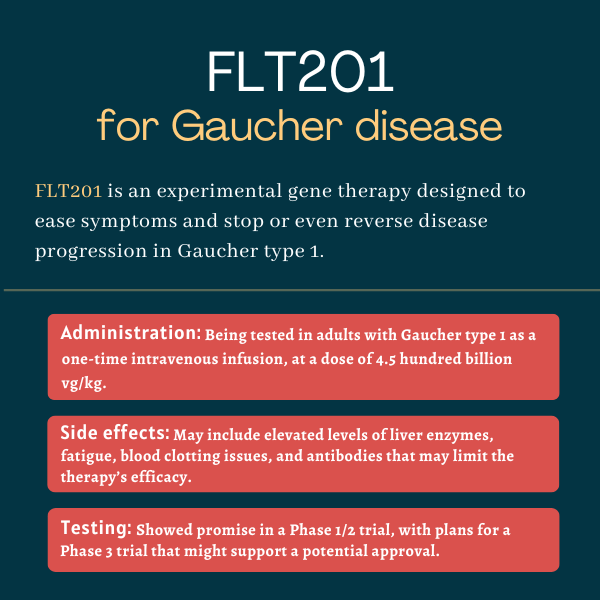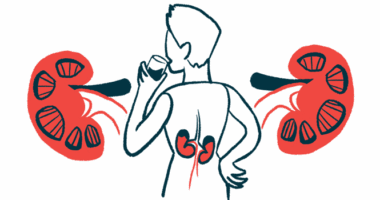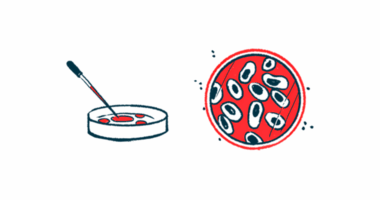FLT201 for Gaucher disease
Last updated March 31, 2025, by Inês Martins, PhD

What is FLT201 for Gaucher disease?
FLT201 is an investigational gene therapy being developed to ease symptoms and stop or even reverse disease progression in people with Gaucher disease type 1, its most common form in Western countries.
Developed by Spur Therapeutics, the therapy is intended to restore production of the glucocerebrosidase enzyme that’s deficient, reducing the accumulation of certain fatty molecules in cells throughout the body. It is administered as a one-time infusion into the bloodstream (intravenous infusion).
FLT201 received orphan drug designation in both the U.S. and European Union (EU) for the treatment of Gaucher. It also was granted a regenerative medicine advanced therapy designation in the U.S. and a priority medicines designation in the EU. These designations aim to expedite the therapy’s development and review.
The gene therapy also is being developed for a subset of people with Parkinson’s disease associated with mutations that are shared with Gaucher patients.
Therapy snapshot
| Treatment name: | FLT201 |
| Administration: | One-time intravenous infusion |
| Clinical testing: | Completed a first-in-human Phase 1/2 trial; a Phase 3 study is planned |
How does FLT201 work in Gaucher disease?
Gaucher disease is caused by mutations in the GBA1 gene, leading to a deficiency of the enzyme glucocerebrosidase (GCase). Because this enzyme, a type of protein, is needed to break down certain fatty molecules, including glucocerebroside (Gb-1) and glucosylsphingosine (lyso-Gb1), these fats accumulate to toxic levels in various cells.
In people with Gaucher type 1, the most common disease type in North America and Europe, glucocerebroside buildup can affect several tissues and organs outside the brain and spinal cord — mainly the spleen, liver, and bone marrow. This causes a range of disease symptoms that can develop between childhood and adulthood.
While several enzyme replacement therapies (ERTs) and substrate reduction therapies (SRTs) are available for people with Gaucher disease type 1, many still experience symptoms after years of continuous treatment.
FLT201 is a gene therapy that works by delivering to liver cells a modified version of the GBA1 gene. This gene version provides instructions to produce a more stable version of GCase, called GCase85, with sustained activity in the body.
The modified GBA1 gene is delivered with Spur’s proprietary viral carrier, called adeno-associated virus serotype S3, that is highly specific to the liver — the main producer of proteins that are secreted into the blood. By targeting liver cells, the therapy promotes the production of high levels of GCase85, which then moves into the bloodstream and is picked up by cells throughout the body.
In preclinical studies, FLT201 demonstrated a greater ability to reach deeper tissues compared with ERT. GCase85 also lasted longer in key tissues and organs affected by the disease, leading to greater reductions in the accumulation of toxic molecules.
The one-time gene therapy is expected to lessen symptoms and stop disease progression in people with Gaucher type 1, while potentially eliminating their need for repeat ERT or SRT treatment.
How will FLT201 be administered in Gaucher disease?
In a Phase 1/2 trial involving Gaucher type 1 patients, FLT201 was administered as a single intravenous infusion, at a dose of 4.5 hundred billion vector genomes per kilogram of body weight (vg/kg).
Based on promising interim safety and efficacy results, this dose was selected for Phase 3 trial testing. Whether this will be the dose used should the therapy gain approval from regulatory agencies, however, is dependent on subsequent Phase 3 trial data.
FLT201 in Gaucher clinical trials
Spur, formerly known as Freeline Therapeutics, launched a first-in-human Phase 1/2 trial called GALILEO-1 (NCT05324943) to assess FLT201’s safety, tolerability, and efficacy in Gaucher type 1 patients.
GALILEO-1
The GALILEO-1 study enrolled six adults with Gaucher type 1 who were being treated with either ERT or SRT for at least two years. All received a single infusion of FLT201, at a dose of 4.5 hundred billion vg/kg.
To prevent the development of neutralizing antibodies against the viral carrier and/or the produced GCase, which could affect treatment efficacy, patients were given a preventive immunosuppressive regimen three weeks after the infusion that continued for up to 16 weeks.
Participants were followed for a period ranging from nine months to 17 months (nearly 1.5 years) after dosing. They were allowed to discontinue their standard ERT or SRT medications if it became evident that the gene therapy was increasing GCase levels in the blood.
All but one patient, who already had antibodies against the viral carrier at the study’s start, was included in the efficacy analysis. Data showed that discontinuation of standard treatment occurred between four and 11 weeks after the FLT201 infusion for four of the five patients; one remained on SRT.
Such discontinuation typically leads to a rapid increase in blood lyso-Gb1 levels and a marked decrease in platelets (cell fragments involved in blood clotting) and hemoglobin (the protein in red blood cells that carries oxygen), indicating disease worsening.
However, FLT201-treated patients discontinuing ERT/SRT experienced a stabilization or reduction in lyso-Gb1 levels. Specifically, the four with elevated lyso-Gb1 levels at study’s start despite being on standard treatments for four to 24 years experienced rapid and durable lyso-Gb1 reductions, by 33%-96%. The remaining patient, who already had well controlled lyso-Gb1 levels at study’s start, continued to show low levels.
Sustained increases or maintenance in hemoglobin levels, platelet counts, and liver and spleen volumes also were seen after stopping standard treatment.
Four patients had reductions in bone marrow burden, indicating that toxic fatty molecules were being cleared in a tissue that is normally difficult to reach with standard therapies, and healthy bone marrow tissue was reappearing. The fifth patient had a stable bone marrow burden despite withdrawal of standard treatment.
Overall, FLT201’s beneficial effects were sustained for more than one year after ERT/SRT discontinuation.
After completing GALILEO-1, all patients chose to enter the long-term Phase 1/2 GALILEO-2 study (NCT06545136), in which they are being followed for up to five years after FLT201 dosing.
Based on the findings, Spur announced plans to launch a Phase 3 trial of FLT201 in 2025. Pending positive data, this late-stage trial may support the therapy’s accelerated approval for Gaucher type 1 based on lyso-Gb1 reductions, or a full approval based on improved or maintained hemoglobin levels.
Accelerated approval is given based on biomarker data from trials suggesting the experimental therapy is expected to be of clinical benefit. Subsequent full approval is dependent on additional trial results confirming the therapy’s safety and efficacy.
Common side effects of FLT201
In its one trial to date, a single infusion of FLT201 was found to be generally safe and well tolerated. The most commonly reported adverse events in treated patients included:
- elevated levels of liver enzymes, suggesting liver damage
- fatigue
- blood clotting issues
- neutralizing antibodies against the GCase enzyme.
There also were reports of side effects related to the immunosuppressive regimen administered after the gene therapy that were consistent with the known safety profile of these medications.
Because this was a small study, more trials are needed to offer a better picture of FLT201’s side effect profile in this patient population.
Gaucher Disease News is strictly a news and information website about the disease. It does not provide medical advice, diagnosis, or treatment. This content is not intended to be a substitute for professional medical advice, diagnosis, or treatment. Always seek the advice of your physician or other qualified health provider with any questions you may have regarding a medical condition. Never disregard professional medical advice or delay in seeking it because of something you have read on this website.
Recent Posts
- Every 2 weeks, my treatment reminds me I have Gaucher disease
- Biomarker could signal when to start Gaucher type 1 treatment
- Real-world study supports VPRIV use in very young Gaucher patients
- Finding moments of grace in seasons of change
- Elelyso yields long-term benefits in type 1 Gaucher: Real-world study






